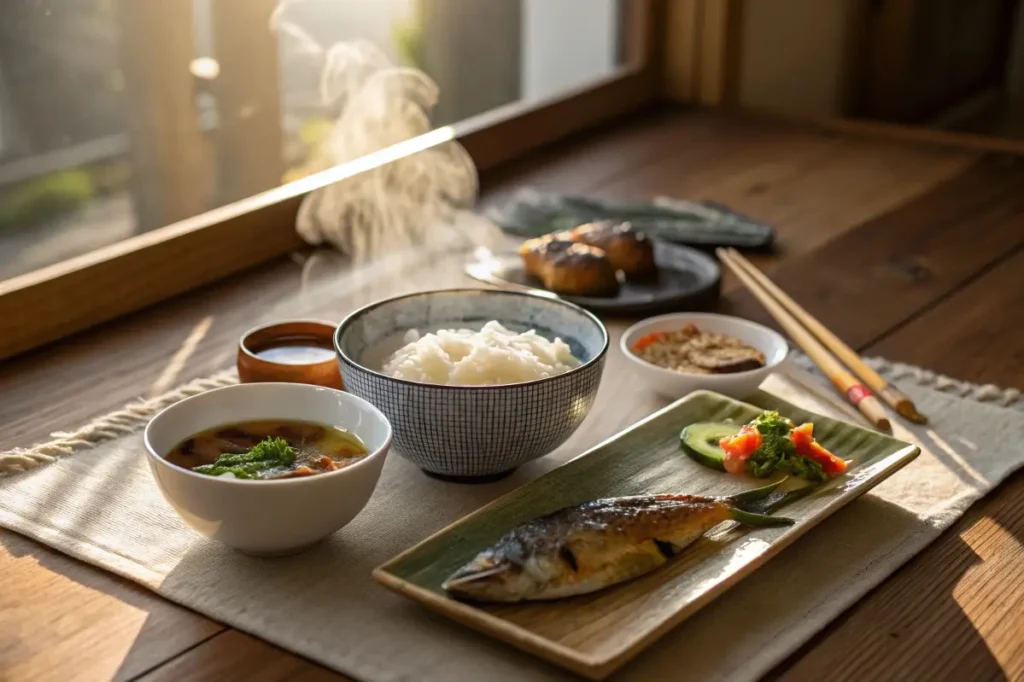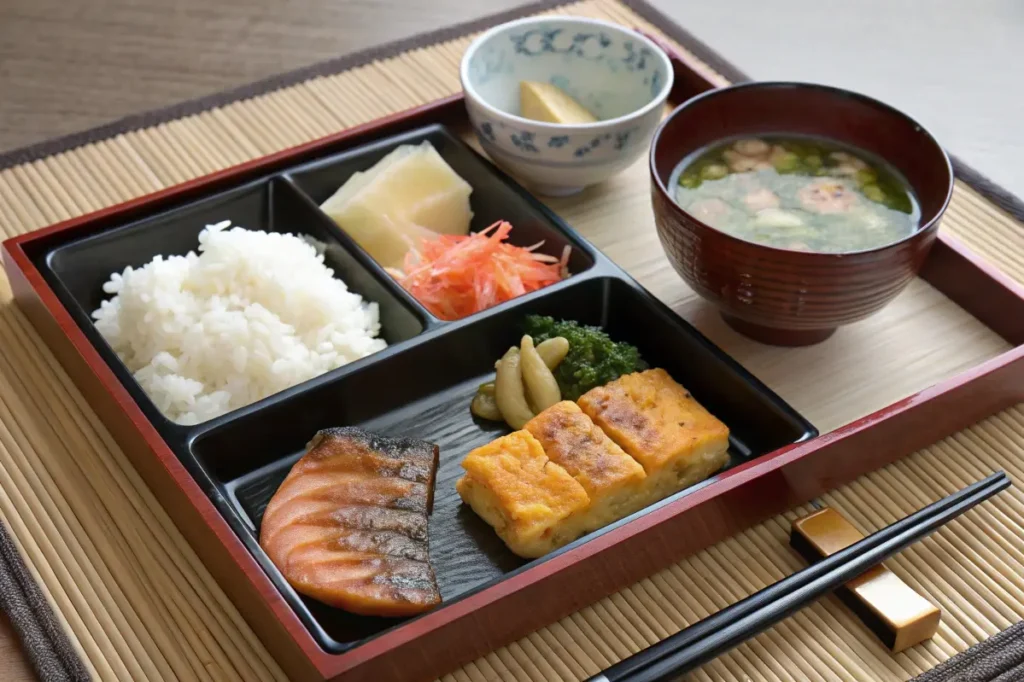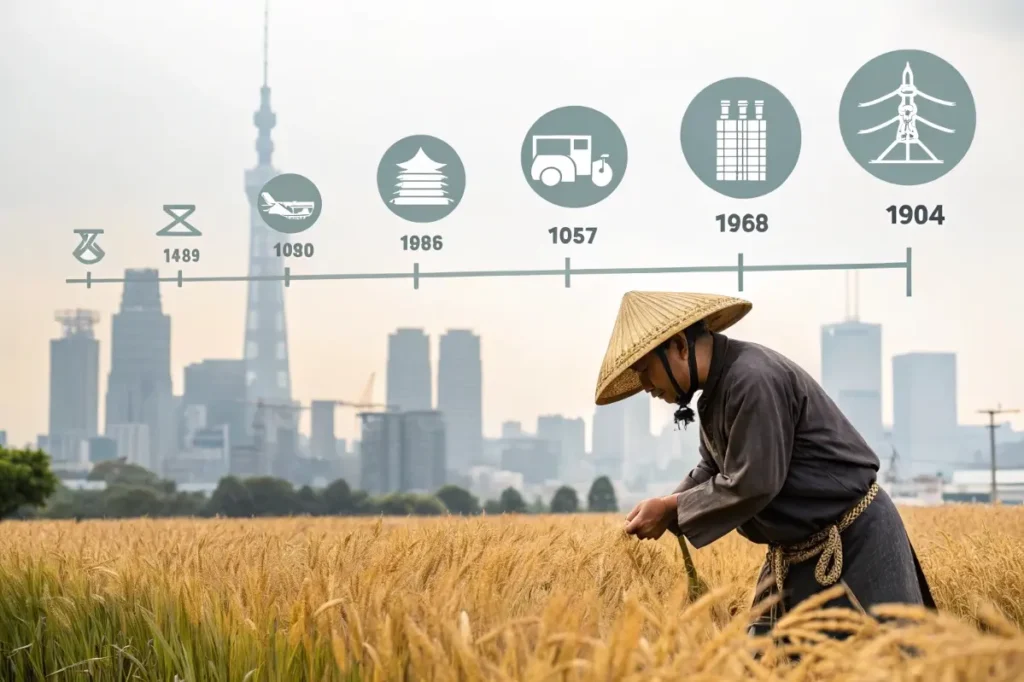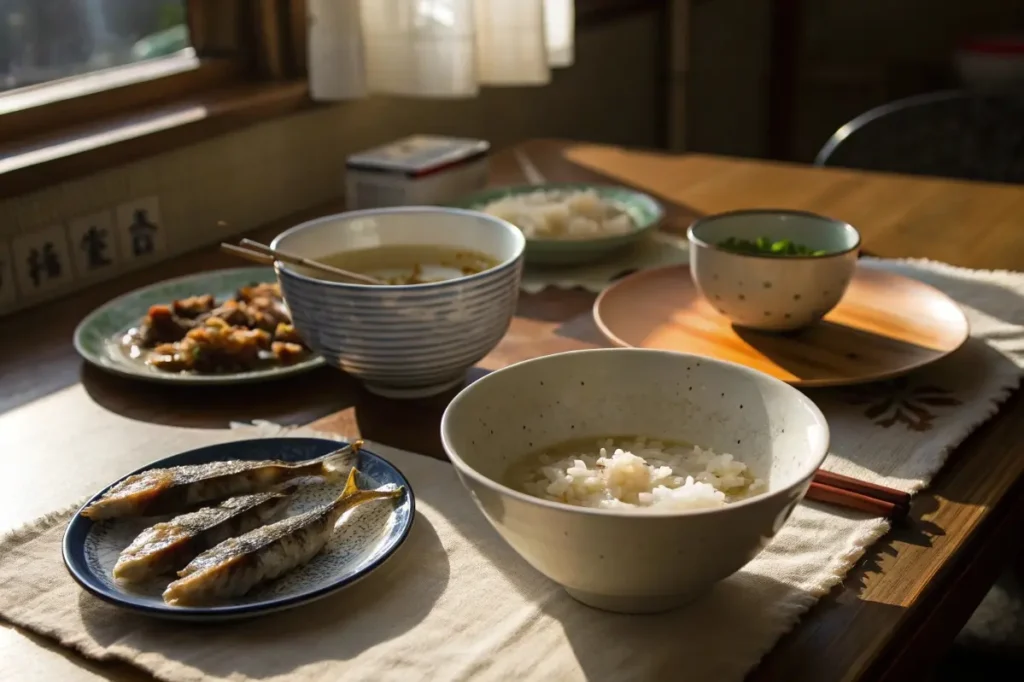Introduction
A well-crafted lineup of japanese breakfast meals can transform an ordinary morning into an invigorating culinary experience. Unlike many Western morning routines centered on cereal or toast, Japanese breakfasts focus on balanced harmony—a mix of rice, soup, fish, and vegetables that together provide nourishment and comfort. This tradition has evolved over centuries, with influences ranging from historical samurai diets to modern convenience foods. Yet the fundamental principle remains unchanged: start the day with synergy among flavors, textures, and nutrients.
In this article, we’ll explore how these meals have shaped Japan’s breakfast culture, what time they’re generally enjoyed, why they’re considered so healthy, and how you can adapt them to your own schedule. We’ll dig into typical items like steamed rice and miso soup, discuss how families manage quick breakfasts on busy weekdays, and even examine the Japanese breakfast rule—a concept emphasizing balance and variety. We’ll also include references to other resources—like typical-japanese-breakfast—so you can discover additional variations and recipes. Whether you’re a seasoned chef or a curious beginner, embracing japanese breakfast meals can add a satisfying and culturally rich dimension to your mornings.

Core Elements of Japanese Breakfast Meals
The Heart of the Meal
A typical spread of japanese breakfast meals relies on essential building blocks that emphasize variety and balance:
- Steamed Rice (Gohan)
- Foundation of the Plate: Short-grain rice, known for its slightly sticky texture, forms the carbohydrate anchor of the meal. Some families opt for genmai (brown rice) for extra fiber.
- Why It Matters: Rice pairs seamlessly with savory side dishes, absorbing flavors from pickles, fish, and soup.
- Miso Soup (Misoshiru)
- Warmth and Umami: Prepared by dissolving fermented soybean paste (miso) into dashi stock, often accompanied by tofu, wakame seaweed, or seasonal vegetables.
- Morning Comfort: The soothing warmth is perfect for jumpstarting the day, promoting hydration and gentle digestion.
- Grilled Fish (Yakizakana)
- Protein Staple: Salmon (sake) and mackerel (saba) dominate the breakfast table. Light seasoning (salt or soy sauce) highlights the fish’s natural flavors.
- Health Factor: Fish delivers lean protein plus beneficial omega-3 fats, revered in Japan’s approach to heart-healthy eating.
- Pickled Vegetables (Tsukemono)
- Palate Cleanser: Crisp, tangy pickles like takuan (daikon radish) or umeboshi (plum) offer acidic brightness, cutting through the meal’s richness.
- Probiotic Benefits: Fermented pickles supply good bacteria for digestive health.
- Egg Variations
- Tamagoyaki (Rolled Omelet): A sweet-savory rolled egg often sliced into bite-size pieces.
- Soft-Boiled or Fried Eggs: Modern households may fry eggs sunny-side up or scramble them with dashi for a quick protein fix.
- Nori or Furikake
- Condiment Essentials: Sheets of dried seaweed (nori) can wrap around rice, while furikake—an assortment of dried seaweed, sesame seeds, and fish flakes—sprinkles flavor onto plain rice.
Balancing the Meal
Each item contributes distinct tastes and textures. Rice acts as a neutral base; miso soup offers salty-sweet umami; fish introduces hearty protein; and pickles deliver a refreshing tang. This layered approach reflects the Japanese breakfast rule: incorporate carbs, protein, and vegetables to ensure a harmonious meal. If you’re short on time, leftover japanese-chicken-fried-rice-recipe can stand in for plain rice, adding a quick but substantial twist to your morning spread.
Adapting to Rushed Mornings
- Prep in Advance: Cook extra rice the night before. Reheat in the morning for minimal hassle.
- Instant Miso Soup: Packets require only hot water, shaving off valuable minutes.
- Fish Alternatives: Replace grilled fish with tofu or leftover chicken if the grill setup is too time-consuming.
Keeping these staples at hand allows for efficient mornings without sacrificing the essence of japanese breakfast meals. Over time, you might experiment with other sides—like natto, a sticky fermented soybean dish revered for its probiotic content. This variety ensures you won’t get bored and can easily accommodate personal taste preferences or dietary restrictions.

Timing and Modern Adjustments to Japanese Breakfast Meals
Busy Weekdays vs. Relaxed Weekends
What time do Japanese eat breakfast? On weekdays, the morning rush typically falls between 6:30 and 8:00 AM. Students catching early trains and office workers juggling commutes often have little time to linger at the table. This reality shapes a strong culture of convenience foods, like onigiri (rice balls) available in konbini (convenience stores). Yet, the essence of japanese breakfast meals—a balanced mix of carbs, proteins, and veggies—remains a guiding principle.
- Morning Hustle
- Quick Onigiri or Bento: Grabbing a packaged salmon onigiri or a mini bento box is common.
- Instant Options: Many stock instant miso soup or leftover fish from the previous night for a speedy solution.
- Bread and Coffee Influence: Some families adopt Western touches—toast, jam, or coffee—for convenience. For more globally inspired examples, see modern-japanese-breakfast.
- Weekend Indulgence
- Expanded Spread: Grilled fish prepared fresh, homemade miso soup with tofu and seaweed, multiple pickle varieties, plus fruit or dessert.
- Family Bonding: Time to talk over the table, let kids practice using chopsticks, or try new recipes like leftover steak-japanese-recipe slices for added protein.
- Brunch-Like Vibe: Some households push breakfast later, blending it into a midday meal with sweet items like pastries or Western-style pancakes.
Why Is Japanese Breakfast So Healthy?
Part of the secret lies in variety and portion control—multiple small dishes ensuring balanced intake of proteins, fats, and carbohydrates. Fermented foods (miso, pickles) also play a role in gut health. Coupled with the cultural habit of hara hachi bu (eating until about 80% full), many find these morning rituals beneficial for maintaining consistent energy levels and healthy weight.
Adaptations for Different Dietary Needs
- Vegetarian or Vegan: Replace fish and eggs with tofu, mushrooms, or extra vegetables. For recipes, check out japanese-vegan-recipes.
- Gluten-Free: Stick to plain rice, and confirm if miso paste is GF-friendly. Switch wheat-based soy sauce for tamari.
- High-Protein Focus: Double up on fish or egg portions, or add leftover minced-beef-japanese-recipe for a hearty kick.
Embracing or Adapting the “Rule”
Even if you can’t replicate a full multi-dish breakfast every morning, adopting the Japanese breakfast rule in moderation fosters a balanced approach. You can incorporate miso soup packets, leftover vegetables, or grilled proteins alongside your preferred carb source—rice, toast, or leftover noodles. This synergy harnesses the spirit of japanese breakfast meals without demanding extensive prep. Over time, you might realize that small shifts—like adding pickles or a quick piece of fish—give your morning a satisfying edge.
History/Context of Japanese Breakfast Meals
A Timeline of Evolving Mornings
While japanese breakfast meals might seem timeless, they’ve undergone notable transformations through different historical periods:
- Pre-Edo and Agrarian Roots
- Early farmers relied on grains like millet or barley. Rice was a luxury in certain regions.
- Mornings centered on sustaining physically demanding work—hearty portions of whatever was locally available, often accompanied by pickled or fermented vegetables.
- Samurai and Feudal Japan
- Contrary to popular myth, samurai didn’t dine on lavish feasts daily. A typical morning mirrored that of commoners: rice, soup, fish, pickles.
- The discipline and routine of the samurai reinforced consistent eating habits, fueling training and duties.
- Edo Period (1603–1868)
- As trade networks improved, fish and produce distribution became more reliable.
- Rice grew more accessible in urban areas, while miso soup diversified with local ingredient variations.
- Merchants and artisans shared morning meal styles akin to modern times—simple yet balanced.
- Meiji Restoration to Early 20th Century
- Western influences introduced bread, dairy, and coffee, though these items remained expensive luxuries initially.
- Government modernization led to dietary reforms, slowly weaving Western elements into Japanese breakfasts.
- Post-War Industrialization
- Shortages post-WWII led to further adoption of cheap, filling staples, including processed bread.
- The rise of an office workforce cultivated demand for quick on-the-go meals—like conbini onigiri—cementing convenience as a core aspect of breakfast.
- Contemporary Outlook
- Tradition coexists with global fusion: a typical meal might feature grilled fish next to a cup of coffee, or leftover Western dinner items integrated into the morning’s side dishes.
- Specialty restaurants and cafés began highlighting japanese breakfast meals for health-conscious diners, reaffirming the cultural pride in balanced, portion-controlled dining.
Why It Matters
This history reveals Japan’s remarkable culinary adaptability. Even with waves of Westernization and modern time constraints, the foundational concept—miso soup, rice, fish, and pickles—has endured. Understanding these roots can enrich your appreciation of how japanese breakfast meals became celebrated for both flavor and health. If you seek more historically inspired dishes, see traditional-japanese-breakfast to witness how timeless methods remain relevant today.

Practical Examples and Use Cases
- The Busy Student
- Scenario: A high school student has only 10 minutes before leaving.
- Breakfast: Leftover rice from dinner, instant miso soup packet, and a quick slice of grilled salmon microwaved from the previous night.
- Outcome: Satisfies the Japanese breakfast rule—carbs, protein, vegetables—using minimal prep. The student heads to class fueled and not hungry mid-morning.
- Office Commute Crunch
- Scenario: An office worker must catch a 7:15 AM train.
- Breakfast: Grabs an onigiri (seafood or tuna-mayo flavor) from the convenience store and a bottled green tea.
- Outcome: Portable, balanced, and reminiscent of home-cooked staples. Even though time is short, the essential elements of japanese breakfast meals remain present.
- Weekend Family Brunch
- Scenario: Parents are off, kids are free, so they plan a more indulgent morning spread.
- Breakfast: Freshly steamed rice, homemade miso soup with tofu, grilled mackerel, pickled cucumbers, and tamagoyaki. Possibly fruit or sweet mochi for dessert.
- Outcome: Everyone slows down to savor a meal reflecting Japan’s communal approach to eating. Kids learn about portion control and respect for each item.
- Fusion “Westernized” Morning
- Scenario: A couple hosting friends who want a Japanese meal but also love Western brunch.
- Breakfast: Avocado on toast with a dash of miso, leftover japanese-curry-recipe-one-piece on the side, plus scrambled eggs sprinkled with furikake.
- Outcome: Merges tradition (curry, miso flavor) with modern brunch staples, ensuring guests get a flavorful cross-cultural experience.
These examples underscore the adaptability of japanese breakfast meals. Whether you have 5, 15, or 60 minutes, you can find a fitting combination of rice, soup, protein, and pickles. Over time, rotating different fish, egg styles, or leftover dinner items keeps your breakfasts engaging and aligned with Japan’s tradition of balanced, deliberate eating.
FAQs about japanese breakfast meals
1. What is a typical Japanese breakfast?
A standard lineup often features steamed rice, miso soup, grilled fish, and pickled vegetables. Some families add tamagoyaki (rolled omelet), tofu, or natto for variety. This arrangement highlights different textures and flavors for a balanced meal.
2. What is the Japanese breakfast rule?
Though not an official rule, it underscores having carbs (rice or bread), protein (fish, eggs, or tofu), and vegetables (pickled or in soup) in one sitting. This well-rounded approach ensures a mix of nutrients right from the start of the day.
3. What time do Japanese eat breakfast?
Weekday mornings typically see breakfast between 6:30 and 8:00 AM, aligning with work or school commutes. Weekends might shift to a later brunch style. If you’re curious about creative weekend ideas, check out discover-japanese-recipes for fresh inspirations.
4. Why is Japanese breakfast so healthy?
Japanese morning meals prioritize diversity in nutrients—lean proteins, whole grains, fermented foods, and vegetables—while controlling portion sizes. Fermented items (miso, pickles) support gut health, and the cultural principle of hara hachi bu (80% full) can prevent overeating.
5. Are fish and miso soup mandatory?
Not necessarily. Some households replace fish with eggs or leftover authentic-japanese-barbecue-sauce-chicken-recipe-easy-delicious for protein. Instant miso soup or even a Western-style soup could stand in for homemade versions when time is short.
6. How do families handle picky eaters?
Offering a range of small dishes can help. Kids might select less “challenging” options like tamagoyaki, rice, or mild pickles. Over time, they gradually explore fish or stronger fermented flavors.
7. Can a Japanese breakfast be vegetarian or vegan?
Absolutely. Tofu, mushrooms, or plant-based proteins can substitute for fish or eggs. Miso soup can be prepared with vegetable-based dashi, and pickles remain a tangy side. For more details, see japanese-vegan-recipes.
Conclusion
Japanese breakfast meals exemplify a cultural commitment to morning nourishment that’s at once simple and profound. From humble bowls of steamed rice and miso soup to quick convenience-store onigiri, they emphasize fresh ingredients, balanced macronutrients, and a respect for each dish’s contribution. Whether you’re drawn to the sweet tang of pickled plums or the savory warmth of grilled fish, every element underscores Japan’s enduring culinary values.
Adapting these meals to your lifestyle doesn’t require an overhaul. You can incorporate leftover dinner items, rely on instant soups, or experiment with Western twists like avocado toast drizzled with soy sauce or miso. Even modest attempts—like adding a small side of pickles or a cup of miso soup—can bring you closer to the synergy that defines japanese breakfast meals.
Ultimately, these morning foods offer more than physical sustenance: they reflect mindfulness, heritage, and a communal spirit that resonates from Tokyo to rural farmlands. By embracing a few staples—like fish, rice, and soup—and respecting portion control, you can capture a bit of Japan’s breakfast magic in your own kitchen. Start small, be curious, and discover how a well-structured morning meal can elevate your entire day.

